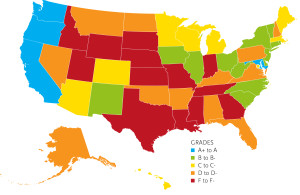As many news feeds have consolidated and well documented, legal access to abortion services has become restricted over the past few years. The latest report from Erik Eckholm for the New York Times includes the graphic shared here that portrays the news in no uncertain form: State legislatures passed 70 new abortion restrictions in 2013 and more over the past three years than they did from 2000 to 2010.

Here a summary of legislation enacted in 2013
3 Bans on abortions at 20 weeks post-fertilization (22 weeks after a woman’s last menstrual period)
4 Restrictions related to reason for abortion, like gender or fetal impairment
4 Amendments to abortion reporting laws
9 Restrictions on abortion providers
10 Limitations on insurance coverage of abortion
17 Limitations on medication abortion
23 Other, includes parental involvement requirements, bans on abortion at 6 or 12 weeks, ultrasound requirements and extended waiting periods.
For the discerning observer, however, some details seem worth dissecting.
1. Restrictions related to reason for abortion includes gender and fetal impairment. For many, these may seem two vastly different reasons, one sounding like but I wanted a boy/girl and the other where something terrible has gone wrong, often cases where the fetus may not make it or be born into a life of tubings. Our supporters may astound at the former, yet sympathize with the latter.
2. Bans on abortions at 20 weeks post-fertilization also seems to be a melting pot. Many fetal deformities are not assessed prior to this time. Is it fair for legislatures to lump expecting parents now facing traumatic circumstances in with those who may just decide very late?
3. The new Restrictions on abortion providers include requiring doctors performing abortions to have local hospital admitting privileges and imposing surgery-center standards on abortion clinics. Here again, what do we believe? What is truly in a woman’s best interest? Many medical procedures nowadays are performed in-office and all procedures are not without risk. For example, plastic surgery and vascular surgery are regularly performed in practices. Are these also unregulated? Actually, we understand no. The same requirements of local hospital registration and surgery-center standards apply. Are the standards inappropriate? Do we accept lesser standards for the sake of upholding access to abortion?
4. Waiting periods: many strong pro-choicers argue against any waiting period at all; they support abortion-on-demand. The cases of failing access to birth control and lack of education are often cited in defense. But the fact is, about half of women having abortions today have been there before, at least once. So the reasoning is shaky. Perhaps such waiting periods would enable care-givers at least two chances to consult patients on their going forward needs. Would this help reduce repeat visits? Imagine, we could halve the abortion rate just by eliminating repeat business. Why is this so difficult?
It seems obscene to even have to pose these questions, yet being in favor of legal abortion access is not without it testing our common sense and any realm of limits.
Here is a full schedule of state laws provided by the Guttmacher Institute if you would like to check where your state stands.
As we move forward toward hopefully keeping legal abortion available and safe, yet making it the rare exception, we need to be cautious of assessments and labeling all legislative initiatives as direct assaults rather than efforts to also bring individual accountability and responsibility into these services. Would you agree?
Like this:
Like Loading...









